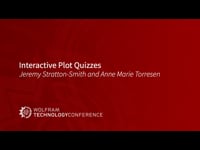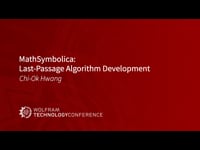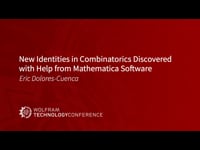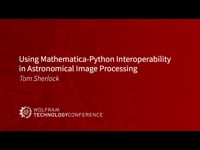3622 videos match your search.
 |
Jeremy Stratton-Smith and Anne Marie Torresen The latest version of Wolfram|Alpha Notebook Edition includes a set of interactive self-driven quiz functions, the first set of which revolves around function plotting for high school/early college ... |
 |
Rodrigo Obando This talk presents a model of cellular automata that includes the ability to examine genetics and a particular gene's effect on a rule or set of rules. |
 |
Olivier Rousselle We consider an atomic system (hydrogen) where we want to observe interference fringes. To do that, we use a small mirror in which the atoms will perform quantum bounces (due to the confinement between gravity and Casimir–Polder potential). We use Mathematica to implement quantum bounces. Such system can be generalized ... |
 |
Soumya Mahapatra and Jayanta Phadikar This talk discusses various tips and tricks for using Wolfram Language to create fast and responsive custom user interfaces. |
 |
Youngjoo Chung This presentation shows an add-on package that facilitates symbolic computation in Mathematica for tensor analysis. This add-on, MathSymbolica, contains over 1,000 functions and its own interpreter language for notation, manipulation and ... |
 |
Chi-Ok Hwang Thanks to MathSymbolica based on Mathematica and developed by Prof. Youngju Chung in Korea, my last-passage algorithm Green function development has been very easy. The symbolic computing becomes complicated as we go from dipole, quadrupole and octupole. However, ... |
 |
Alec Shedelbower Learn how to achieve more realistic graphics with physically based rendering (PBR) in the Wolfram Language. PBR is an approach to rendering that attempts to model the behavior of light ... |
 |
Jason Biggs This talk will showcase new functionality for working with the Molecule, a symbolic representation of a chemical species introduced in Version 12 of the Wolfram Language. Topics will include seamless integration ... |
 |
Jon McLoone This talk demonstrates a web-based application designed to automate the performance of DSE reviews built using Wolfram Application Server, explains the application architecture and discusses issues such as user authentication, ... |
 |
Paco Jain and Oleg Marichev This talk presents a new approach to fractional order integro-differentiation, possible thanks to a newly published function in the Wolfram Function Repository---ResourceFunction ["FractionalOrderD"]. |
 |
Jaebum Jung |
 |
Charles Pooh |
 |
Yuzhu Lu Mathematica Graphics has a new experimental support for using existing OpenGL Shading Language (GLSL) files to customize 2D/3D graphics rendering through surface appearance. It has been used to develop ... |
 |
Keiko Hirayama and Jason Martinez Wolfram Language provides a wealth of computational tools for improving and maintaining health and fitness. Using Wolfram|Alpha Notebook Edition, we show the breadth of information available related to nutrition, ... |
 |
Brian Van Vertloo |
 |
Eric Dolores-Cuenca In our study of nonlinear Signal-flow graphs we used the software Mathematica to obtain evidence about new combinatorial identities. Eventually we proved those identities. |
 |
Oliver Grasl Automating state-of-the-art, multichannel content creation and delivery is a sophisticated and involved process. This presentation illustrates how Wolfram technologies can be used to pull content from diverse sources such as ... |
 |
Tom Sherlock By using facilities built into Mathematica for calling into other languages like Python, one can leverage existing libraries and algorithms for performing specialized image processing workflows. |
 |
Jofre Espigule-Pons This talk will introduce the transformer machine learning model, which revolutionized the field of natural language processing. Then I will present M2M -100, the first multilingual machine translation (MMT) ... |
 |
Ming Hsu This presentation discusses validity challenges to AI algorithms and demonstrates the ways linguistical and social biases still pervade AI training. |